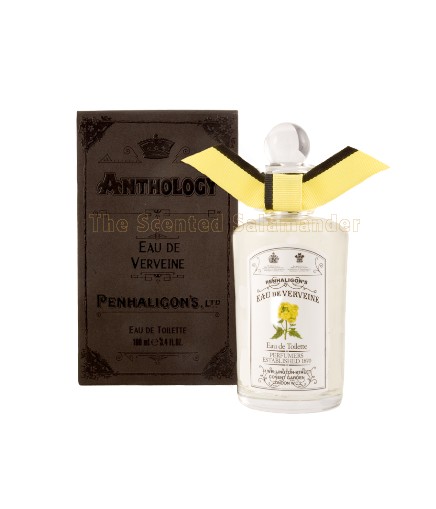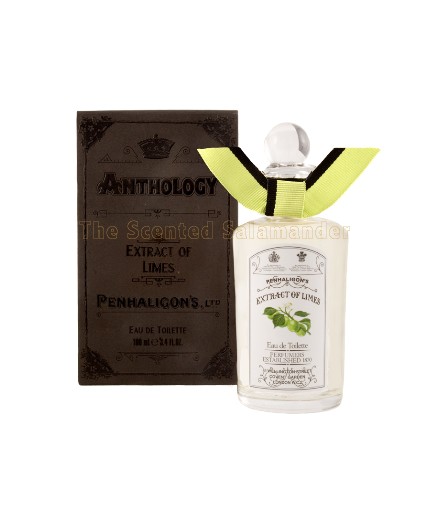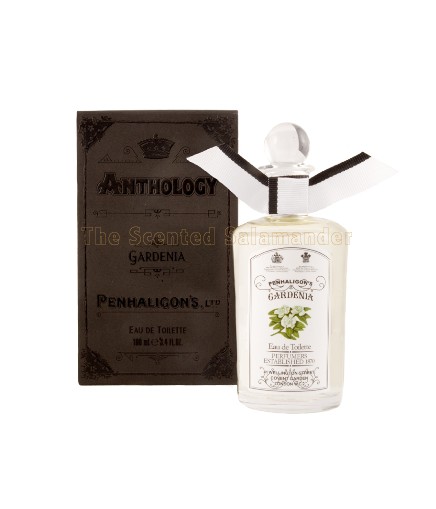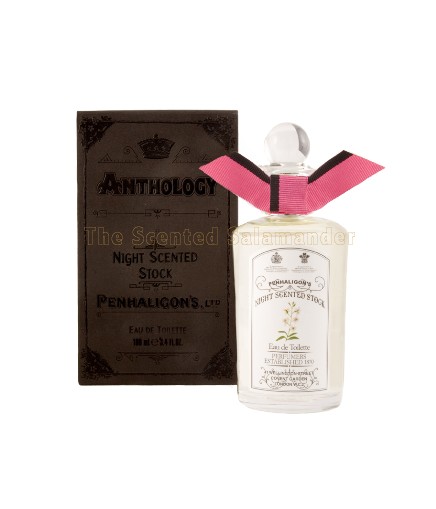Penhaligon's Anthology Part 1: Eau de Verveine (1949), Extract of Limes (1963), Gardenia (1976), Night Scented Stock (1976): Archival Papers Dipped in Contemporary Solutions or Duchaufour Unleashed {Perfume Reviews} {New Fragrances}
 Penhaligon's Anthology is a new collection of fragrances launched this month by an old British house established in the late 1860s by newly arrived barber William Henry Penhaligon (no one seems to know the exact year of foundation). As the name of the collection indicates, there is an archival bent to this project, at least initially.
Penhaligon's Anthology is a new collection of fragrances launched this month by an old British house established in the late 1860s by newly arrived barber William Henry Penhaligon (no one seems to know the exact year of foundation). As the name of the collection indicates, there is an archival bent to this project, at least initially.
The brand plans to release four more "archive fragrances" as they call it in 2010 and a further four in 2011. The revival of these scents were entrusted to perfumer Bertrand Duchaufour and fragrances manufacturer CPL. The nose is now better-known as the master-perfumer for L'Artisan Parfumeur, .
Duchaufour, as it has become obvious by now, has a non-exclusive contract with the house, which works both ways; one of the latest perfumes by L'Artisan, Côte d'Amour, was created by an external perfumer, Céline Ellena.
You are very tempted to nickname this Anthology "Duchaufour Unleashed" as you did not anticipate that it would bear so many of his personal touches. It is also an opportunity to catch a side of his that seems almost rebellious, and certainly anti-conformist.
It seems that in Bertrand Duchaufour there is the dream of being a romantic young rebel à la James Dean.
Eau de Verveine (1949)
Notes: citrus, woods, soft metallics, crumbled herbs, spices, musk and vanilla.
The initial impression is aromatic, a bit iris-y and sweetly ambery. It is less fresh and herbal than one might have expected from the name of the fragrance, and more constructed around the idea of the culturally-connoted distinguished trail for the gentleman as it plays on subtle woodsy and even subtler leathery undertones. I was expecting a verbena infusion, it is more of a verbena-tinged ambery men's cologne. The signature is classic, with the slight twist that it is a warm ambery fougère rather than a cool, bracing one.
It evokes the type of toiletries one might find in the mahogany paneled bathroom of an exclusive British gentlemen's club...

The scent craddles, interestingly, a delayed secret recall of a toned-down version of the famous avant-gardist circus accord found in L'Artisan Parfumeur Dzing! created by Olivia Giacobetti mixed here with some lavender.
And I was not even trying to make a comparison with the perfume house where perfumer Bertrand Duchaufour is the resident nose. Giacobetti herself incidentally is no stranger to Penhaligon's as she developed last year a flanker for their Hammam Bouquet (1872), Elixir (2008).
As befitting a gentleman, Eau de Verveine does not want to intrude nor impose fading into a faint trace of fragrance on the skin.
Extract of Limes (1963)
Notes: West Indian lime, lemon oil, neroli, blossom honey.
Again a traditional signature of lime-based extract for the gentleman, only with a smidgeon of musky dirtiness as in a tinsy headspace whiff of unwashed buttocks, to be quite frank. To my nose and after the initial prolonged and screechy, sharp citrusy burst which the brand prefers to describe as "shattered sherbet", it is a photo-realistic recall of the scent emanating from men's urinals.
The picture that forms in my mind is that of a retro white-tiled bathroom this time with a soap dispenser in the shape of a whiz-bang, the kind that you needed to turn upside down with its weight system to make a mother-of-pearl soft soap ooze out. It all smelled like a mix of generic old-fashioned soap, urine, and some citrusy waft coming from an unknown source: the urinal cakes? the detergent the cleaning lady uses?
It does not smell bad really and is in fact quite evocative. It is just not a pretty scent. If Comme des Garçons had come up with a composition titled Urinals ca. 1960s, this is pretty much how I would expect it to smell.
I am afraid my description might be negatively interpreted, but it is in fact a positive assessment of a retro men's bathroom accord, one that is less upper-crust than in Eau de Verveine, yet just as real.
Our library of olfactory sensations needs to expand and I am glad a bubble in time was captured. I know that this is not precisely ad-copy material but believe me, I like this scent.
One might venture to say that Bertrand Duchaufour decided to play on subliminal emotional associations and/or made the decision to insert - brilliant! - very contemporary and even avant-garde accords in perfumes that come with a historic anthology label.
A scent for nostalgics or people who might not be aware that men's bathrooms carry an emotional charge and can be just as other more romantic settings imbued with memories.

Gardenia (1976)
Notes: tuberose, jasmine, gardenia, ylang ylang, spices, vanilla.
A creamy deeply indolic and nefarious gardenia accord opens with a lot of the blue-cheese-smelling type indoles. Here it smells distinctively of fresh Roquefort and a not-too-ripe Stilton with more of a bite than a mellowed, round scent. Again I am struck by the olfactory choices and sometimes risks that Bertrand Duchaufour took to publish this Anthology.
His choices either subvert the idea of classicism in Eau de Verveine or exploit the aesthetic sensation of borderline ugliness in Extract of Limes and Gardenia.
After this initial strong statement, the perfume becomes much more tame and whispery, even basic and neutral with a super minimalist oriental white musk and white amber drydown that seems to turn one's skin into a sheet of blank white paper.
This is a bit strange as the scent does not seem to want to follow a pyramidal composition but rather like, again, an avant-garde theater play or music play, to start with the staging of raw brutal emotions bordering on cacophony. After the mayhem follows murmurs than silence.
A very contrasted piece of work which, if I have well understood its intent, is the most conceptual gardenia perfume I have ever smelled.
The reason why I am ascribing an intent to this composition rather than to think that money ran out to construct a full perfume is that the two previous perfumes also bear the same type of hidden contemporary agenda in the midst of an official historic, archival program.
After a moment of respite, the gardenia floral note surfaces again accented this time with a fruity facet. It smells pretty, still a bit cheese-y. After the revolt, the alienation, the muzzling, the gardenia flower comes around to accept the rules of society in the last act.

Night Scented Stock (1976)
Notes: clove, heliotrope, violet, vanilla, musk, tonka bean.
An opening of terrible beauty with different types of indoles than in Gardenia: nail polish, synthetic leather, acetone-smelling indoles, furniture polish. A sentiment of intoxication and brutality at the same time in which honeyed notes sweeten, just a bit, the raspiness.
After this initial fanfare, which seems to offer the vision of Night Scented Stocks caught in a moment of rioting the perfume mellows down to a slightly camphor-tinged soft heliotropine, tonka bean and woodsy drydown evocative of Chinese lacquer boxes that would contain furry, velvety almonds.
A floral oriental that smells like the Opium Wars and the Boxers Rebellion all at once. A counter-cultural version of Opium by YSL with a simplistic yet lovely drydown.
One cannot but be struck in the end by the ways in which perfumer Bertrand Duchaufour appropriated to himself the briefs for the perfumes. The Anthology by Pengaligon's smell like a carte-blanche project. Behind those demure bows and classically shaped bottles are hiding some very personal statements and quirks. The only trace I can find of this mad liberty is this passage in the ad copy,
"Many of the fragrance formulations have remained unchanged since conception, offering a unique insight into the fragrance tastes and trends of the era, while others have been carefully reformulated to ensure they appeal to modern fragrance wearers while still retaining a unique heritage feel."
But otherwise I have never smelled perfumes that corresponded so little to their press descriptions. From a technical point of view, do not expect these perfumes to be long-lasting or offer complex developments overtime. Where the Anthology fragrances remain true to the traditional toiletries persona of the brand is in their ultimate collective resolution to smell discreet in the end.









